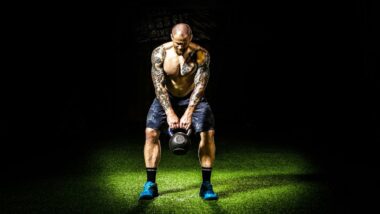Kettlebell squats target multiple muscle groups, including quadriceps, hamstrings, glutes, and core muscles. This exercise improves overall lower body strength and stability. The quadriceps and hamstrings work together to extend and flex the knees, while the glutes contribute to hip extension. Core muscles, such as the abdominals and lower back, engage to maintain proper form and stability. As the movement is executed, various muscle groups work in tandem, and understanding the intricacies of this exercise can further enhance its benefits and overall effectiveness. Further exploration of the movement can reveal its full potential.
Key Takeaways
- Kettlebell squats work quadriceps and hamstrings.
- Glutes are engaged for strength and power.
- Core muscles provide stabilization and control.
- Legs and hips are targeted for strength.
- Multiple muscle groups are worked simultaneously.
Kettlebell Squat Benefits
Incorporating kettlebell squats into a workout routine can yield numerous benefits, particularly with regards to overall lower body strength and flexibility. This kettlebell exercise, also known as goblet squats, is a effective squat variation that targets multiple muscle groups.
By engaging the core muscles, kettlebell squats help improve core strength, which is essential for overall stability and balance. As a form of strength training, kettlebell squats can help build lower body strength, making everyday activities easier and reducing the risk of injury.
The benefits of kettlebell squats extend beyond physical strength, as they can also improve flexibility and mobility. By incorporating kettlebell squats into a workout routine, individuals can experience significant improvements in their overall physical fitness and well-being.
This exercise is a valuable addition to any strength training program, providing a thorough workout for the lower body and core muscles. Regular practice of kettlebell squats can lead to noticeable gains in strength and flexibility. Incorporating kettlebell squats into a workout routine can also enhance kettlebell swing techniques, allowing for a more comprehensive full-body workout.
Muscles Worked Explained
Engaging in kettlebell squats effectively targets multiple muscle groups, including the quadriceps, hamstrings, glutes, and core muscles, thereby providing a thorough workout for the lower body. The squat exercise works the muscles in the front and back of the legs, promoting overall lower body strength. The kettlebell adds an extra challenge, engaging the core muscles to maintain stability and balance throughout the movement.
As individuals perform the kettlebell squat, they activate the muscles in their lower body, including the quadriceps and hamstrings. The glutes are also worked, contributing to the development of strength and power. The core muscles, including those in the front and back, play a vital role in maintaining proper form and executing the exercise safely.
This exercise is an example of a full-body movement that can help improve overall fitness and increase strength in a short amount of time.
Squat Technique Guide
The muscles worked by kettleball squats are most effectively targeted when proper technique is used. To achieve this, prioritize proper form by holding the kettlebell in a goblet position, with feet shoulder-width apart and toes slightly outward.
The movement begins by pushing hips back and bending knees, maintaining an erect chest and neutral spine. As you lower into the squatting position, keep the kettlebell close to the body and engage your core. The kettlebell goblet squat and kettlebell front squat both require this attention to form.
Regular practice of kettlebell exercises, including squats, can lead to improved muscle strength and overall fitness, making it an effective way to get fit in a short amount of time.
Core Engagement Details
The core plays a vital role in kettlebell squats, as it provides the necessary stabilization to maintain proper form and generate force.
Core stabilization is essential to prevent injury and guarantee a effective transfer of power from the lower body to the kettlebell.
Muscle activation in the core, including the abdominal and lower back muscles, is also critical to maintain control and balance throughout the entire range of motion.
This is particularly important for achieving overall full-body workout benefits, as kettlebell exercises often require the use of multiple muscle groups at once.
Core Stabilization
Stability is essential during kettlebell squats, as it enables individuals to maintain proper form and generate force efficiently. The core plays a critical role in stabilizing the body, particularly when holding a kettlebell in front.
Core stabilization is essential to prevent unnecessary movement and maintain a straight back, which is essential for safety and effectiveness. The rectus abdominis and erector spinae muscles work together to stabilize the core and upper body, ensuring a strong foundation for the lift.
Proper core engagement helps to maintain a straight back and stable lower back, reducing the risk of injury. When performing kettlebell squats, it is essential to engage the core muscles to support the upper body and maintain control throughout the movement.
Muscle Activation
Engaging core muscles is essential for maintaining control and generating force during kettlebell squats. The core muscles, including the rectus abdominis, obliques, and transverse abdominis, work together to provide stability and balance throughout the movement. As a compound exercise, kettlebell squats require muscle activation across the entire body, from the chest and upper back muscles to the core muscles and beyond.
During kettlebell training, the transverse abdominis muscle plays a vital role in providing additional stability and support to the spine and pelvis. Activation of the core muscles helps to increase intra-abdominal pressure, providing a stable base for the body to move. This enables individuals to perform the squat movement with proper form and technique, engaging the correct muscle groups and minimizing the risk of injury. By incorporating kettlebell squats into their workout routine, individuals can strengthen their core muscles and improve overall muscle activation, leading to a stronger and more stable body.
Leg Muscle Activation
Muscle activation in legs during kettlebell squats primarily involves quadriceps, hamstrings, and gluteals, which work together to facilitate movement and maintain posture. This activation is vital for a stable and effective squat. Including the quadriceps, the thigh muscles play a significant role in leg muscle activation.
When performing a bodyweight squat, standing with feet hip-width or feet shoulder-width apart can affect the level of activation. Standing with feet shoulder-width apart can increase the activation of the quadriceps and gluteals. To build strength and sculpt a resilient lower body, it is essential to focus on proper form and technique.
Leg muscle activation is critical in kettlebell squats, as it helps to maintain balance and generate power. By understanding how to activate the leg muscles, individuals can optimize their workout and achieve their fitness goals. Proper stance, including standing with feet hip-width or shoulder-width apart, can enhance leg muscle activation and overall exercise effectiveness. Effective kettlebell workouts also require attention to back muscles to prevent injury and ensure a full-body exercise.
Full Body Workout
As kettlebell squats involve the simultaneous activation of multiple muscle groups, they constitute a highly effective full-body workout, targeting the quadriceps, hamstrings, glutes, and core muscles. This functional movement engages the muscle groups in the thighs, promoting overall physical fitness and enhancing the range of motion.
The squat position, characterized by an upright torso, requires the activation of various muscle groups to maintain stability and balance throughout the movement.
Kettlebell squats are a valuable addition to any fitness routine, as they work multiple muscle groups simultaneously, making them an efficient and effective way to improve overall fitness. The movement requires engagement of the core muscles, glutes, and legs, promoting a full-body workout that can help improve physical fitness and overall well-being.
Exercise Safety Tips
When performing kettlebell squats, prioritizing safe lifting techniques is essential to prevent injuries and guarantee a successful workout.
Proper form is also vital, as it enables individuals to effectively engage the target muscles while minimizing the risk of harm to their joints and surrounding tissues.
Safe Lifting
Proper form and technique are vital components of safe lifting, and their importance cannot be overstated in the context of kettlebell squats. To guarantee safe lifting, having proper form is indispensable, keeping the core engaged and the spine in a neutral position.
Choosing a weight that allows for controlled movement is also critical, as lifting with a weight that is too heavy can lead to poor form and increase the risk of injury. This, in turn, can affect balance and stability during kettlebell squats. Maintaining a neutral spine and keeping the core engaged helps to prevent injury and guarantees safe lifting.
Proper Form
Maintaining proper form is essential for anyone performing kettlebell squats, and one key aspect of this is keeping the back straight and engaging the core throughout the exercise. To achieve proper form, it is essential to stand with feet shoulder-width apart, allowing for a stable position and even weight distribution. When holding the kettlebell, keep it at chest height with elbows close to the ribcage, maintaining a tall posture.
As you lower your body into a squat position, keep the kettlebell at chest height and maintain a neutral spine. Pushing your feet into the ground will help initiate standing up, engaging your glutes and quadriceps.
Proper form is vital for a safe and effective workout, and choosing a weight that allows for 2-3 sets of 10-15 repetitions with good technique is essential. By focusing on proper form and engaging your core, thighs, and other muscle groups, you can guarantee a successful and injury-free kettlebell squat exercise.
Warm Ups
A thorough warm-up routine is essential for a safe and effective kettlebell squat exercise, as it prepares the muscles for the physical demands of the workout and reduces the risk of injury. A proper warm-up consists of 5-10 minutes of light cardio and dynamic stretching to increase blood flow and flexibility. Exercises like leg swings, lunges, and calf raises target the same muscle groups used in kettlebell squats, helping to prepare the muscles for the upcoming exercise.
Incorporating bodyweight squats and lunges into the warm-up routine can also help improve ankle mobility, which is vital for the upward phase of the kettlebell squat. Additionally, mobility exercises can help improve range of motion and reduce the risk of injury in the hips, knees, and ankles. By including these exercises in the warm-up, individuals can guarantee a safe and effective workout, and feel confident and connected to their fitness community as they work towards their goals.
A well-structured warm-up routine sets the stage for a successful kettlebell squat exercise.
Frequently Asked Questions
Are Kettlebell Squats Effective?
Kettlebell squats are effective, offering squat benefits, improved muscle activation, and strength gains, enhancing athletic training and overall fitness goals through varied weight lifting techniques in a workout routine.
How Many Kettlebell Squats a Day?
Incorporating kettlebell squats into a daily routine requires balancing exercise safety with personal goals, considering workout planning and muscle recovery to achieve strength gains and proper body alignment.
Will Kettlebell Squats Grow Glutes?
Eighty percent of kettlebell squat beginners notice glute development, emphasizing proper kettlebell form and squat technique for ideal muscle growth in a weight training exercise routine focused on lower body strength building.
What Are the Benefits of Kettlebell Front Squats?
Kettlebell front squats enhance squat technique, promoting muscle activation, and contributing to exercise routine, strength training, and fitness goals through weight lifting, optimizing athletic performance and power development effectively.
Conclusion
Kettlebell squats ignite a fire that fuels overall fitness, symbolizing a foundation of strength. This exercise strengthens muscles, nurturing stability and power. A robust body emerges, like a phoenix from ashes, as kettlebell squats kindle a transformative journey. Effective technique and core engagement forge a resilient physique, underscoring the squat's significance in a full-body workout regimen.


